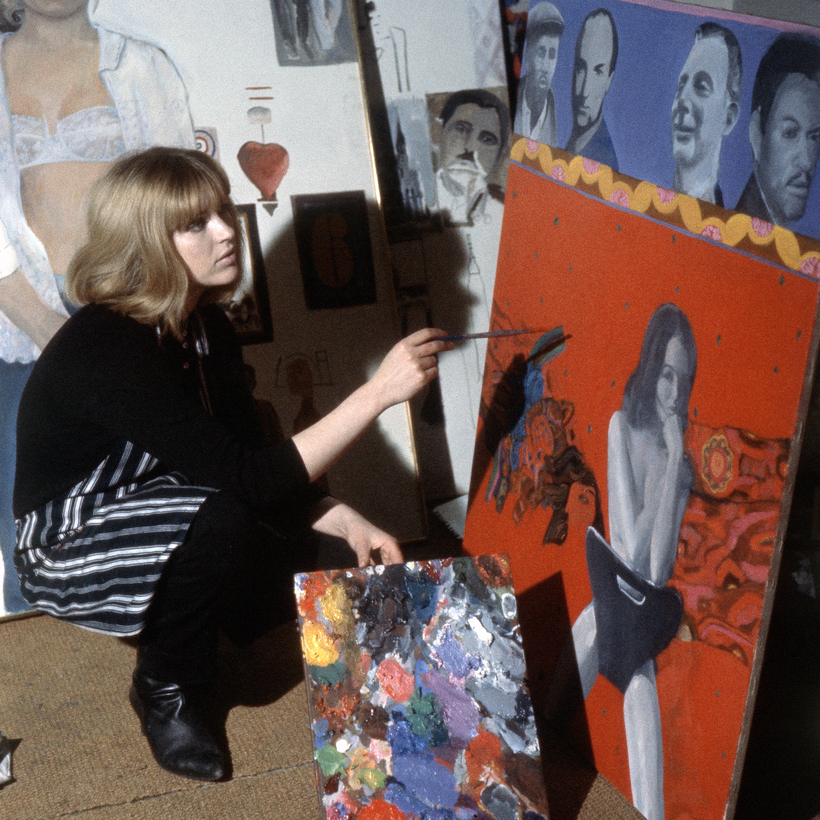It was almost exactly a decade ago, in 2013, that I saw my first Pauline Boty painting. Like so many of life’s transformative events, my presence that October day at Christie’s, in London—standing before the artist’s 1964 canvas It’s a Man’s World I—was a fluke: I’d been passing the auction house when it began to rain, and with time to kill, not wishing to get wet, and intrigued by the exhibition’s title (“When Britain Went Pop: British Pop Art—The Early Years”), I went in.
Boty’s artwork instantly captured my attention, startling me with its wit and bite—its celebration of the glamour of a man’s world and simultaneous condemnation of its violence—and I felt the artist’s personality strongly, almost as though the picture were a self-portrait. Thus I was surprised, looking at the card on the wall, that Boty’s name was completely unknown to me. And that she’d died so young—at 28, in 1966. So I thought I’d look her up.

What I discovered was remarkable. After graduating, in 1958, from the Wimbledon School of Art—where her beauty and allure earned her the nickname “Wimbledon Bardot”—Boty attended London’s Royal College of Art during its dynamic postwar years, schooling alongside the likes of David Hockney, R. B. Kitaj, and Allen Jones, and going on to become not only a foundational member of the British Pop-art movement but one of its very few females.
Pauline Boty’s artwork startled with its wit and bite—its celebration of the glamour of a man’s world and simultaneous condemnation of its violence.
Boty also worked as an actress—losing out to Julie Christie for the female lead in John Schlesinger’s Billy Liar (1963), then appearing opposite Michael Caine in Alfie (1966)—and was a political activist, a social critic (delivering acerbic jeremiads on BBC radio’s The Public Ear), and a feminist. Indeed, in her day Boty seemed ubiquitous: starring with the painters Peter Blake, Derek Boshier, and Peter Phillips in Ken Russell’s documentary Pop Goes the Easel, dancing on the landmark rock ’n’ roll TV program Ready Steady Go!, posing for the era’s great photographers, notably David Bailey and Lewis Morley.

I had never written a biography and had no art-historical training. But Boty’s story, I believed, was significant, owing not only to the originality of her work, but to her nature. Unlike most of her contemporaries, the artist didn’t see why she had to do one thing, or see life, so complex and contradictory, in one way.

Boty’s definitive trait was a refusal to be pigeonholed, to conform to expectations, to play by the rules. She had a confidence, a comfort with herself and a willingness to put that self forward, that remained highly unusual, especially for women at the time, and perhaps female artists in particular, who—struggling to be taken seriously—tended toward sobriety and understatement. It seemed incredible that this icon of Swinging London had been, for decades, largely forgotten. It was an oversight demanding redress.
So I dove in.
Across a decade of work—sustained by the 100-plus individuals with whom I spoke, people exceptionally forthcoming with their memories, observations, and advice—I remained privately troubled by the circumstances of Boty’s death. In 1965, married to the literary agent Clive Goodwin (10 days after meeting him), and discovering that she was both pregnant and suffering from cancer, Boty chose to postpone proper treatment until the baby arrived, and she died four months after the birth of a daughter, whom the couple named Boty.

I considered the artist’s decision to fatally privilege the life of her unborn child over her own to be inexplicable, and I questioned many of Boty’s intimates about her choice. But it was an individual who’d never met her—the author and political activist Tariq Ali, a close friend of Goodwin’s—who offered an answer. According to Ali, Boty had explained her choice to Goodwin by saying, “At least there will be something left of me, for you and the others to remember when I’m gone.”

I confess I found this deeply disturbing. Why would a woman as broadly accomplished as Pauline Boty feel she needed an heir to keep her memory alive? Could she have thought so little of her many achievements, in so many arenas, that she was prepared to die to give birth? If so, it would seem to be the ultimate capitulation to “a man’s world.”
Yet, like so many aspects of Boty’s life, its conclusion was open to interpretation. Over and again, the artist’s friends spoke to me of her defiance, her determination to do things her own way, her joyful embrace of self-contradiction. Rather than a failure of self-belief, I came to understand that Boty’s choice could be seen as a powerful, even radical, act of optimism, the ultimate example of the right to choose: a story ending not in surrender but with independence, hope, and love.

Today, Boty is emerging from history’s glacial ice into a world more receptive to her sensibility than the one in which she lived. Last July, a commemorative “blue plaque” was unveiled at her Holland Park residence; the Tate Britain has returned Boty’s most famous painting, The Only Blonde in the World, to its walls; and a comprehensive exhibition—the first in a decade—opens at London’s Gazelli Art House on December 1. A bold woman to the very end, a singular creator, and a culture figure for our time, Pauline Boty, lost for so long, has at last been found.

Pauline Boty: British Pop Art’s Sole Sister, by Marc Kristal, is out now from Frances Lincoln

